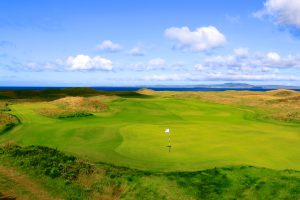The Machrie Links uses premium grass seed for renovation
Related Articles
With 20 years’ greenkeeping experience at major Scottish golf courses, Dean Muir was “looking for something a little bit different” three years ago when he upped sticks for The Machrie Links. And he’s certainly succeeded in his ambition.
As one of the most picturesque golf courses in the UK, set in the dunes on Laggan Bay off the coast of the Isle of Islay, the 126-year-old course now blends Scottish golfing heritage with one of the most modern links courses in the UK after a three-year full reconstruction.
“When I arrived it started out as a small project, with a few changes and course conditioning, but over the last three years the whole course has undergone a complete renovation,” says Muir, who hopped from east coast to west coast when he swapped his role as deputy course manager at Muirfield, Edinburgh – home to the Honourable Company of Edinburgh Golfers, one of the oldest golf clubs in the world – for The Machrie.

The Machrie Links, Isle of Islay, Argyll and Bute, Scotland. (Picture Credit / Phil Inglis)
Keeping much of the 18-hole course open throughout the build might be a challenge for most greenkeepers, but it seems Muir has sailed through. “We’ve already had some fantastic feedback about the condition of the course, which I put down partly to the new grass seed, a special mix with Barolympic perennial ryegrass – it’s a real game changer for the industry,” he says.
Par for the course
Originally designed in 1891 by Willie Campbell, the old links course was renowned for its stunning location and quirky nature – and among the top 100 courses in the UK.
“It had 17 blind shots so it was very tricky to play, in fact, elements of it were quite dangerous and the low hollows meant parts of it remained submerged under water for two to three months of the year,” says Muir.
Now, thanks to a full modernisation, led by D J Russell, the former European Ryder Cup vice captain and PGA tour player, The Machrie mimics an Irish style links course with high dunes and an undulating course, with spectacular views of the sea from many of the holes.
Despite working around some major earthworks and a hotel building site, Muir has been able to produce some top-notch greens, tees and fairways.
“After discussion with Dave Greenshields from Barenbrug, I was recommended Barolympic straight away but I was very dubious about it at first. I couldn’t see how a ryegrass would work on the fairways and tees – but it has been fantastic,” he says. “It’s not the typical grass to use on a links golf course but it’s so fine and pale it blends really well with the fescue. It looks like fescue and plays like fescue but has the wear tolerance of ryegrass.”
Tee off
Quick germination has been the key to its success, especially in a location like The Machrie’s, where the course is regularly exposed to wind and salt, and sowing takes place in pure sand. While the greens have been reconstructed from the former turf and reseeded with fescue, the fairways and tees have all been seeded with the Barolympic mix, a subtle variation on popular products BAR Platinum and BAR MEDAL.
“The seed has been fantastic at dealing with the changeable climate, and has established very quickly – four to five days compared with usual seven to 10,” adds Muir.
While the Gulf Stream allows for warmer temperatures, and very little frost or snow, the grass has had to compete with year-round low light levels and very high rainfall.
“The change in the climate from east to west coast has been a real eye-opener for me,” says Muir. “On average, there’s around 1,600ml of rainfall compared with 600 to 700ml on the east coast. Couple this with the high winds and it means grass seed can literally be blown away overnight. But Barolympic has allowed us to achieve germination throughout the year.”
Sail against the wind
The team at The Machrie have used a hydro-mulch to get around the windy location, sowing directly into the sand and sealing with a papier mâche-style solution.
“This has helped hold the seed on the surface and prevents it blowing away or being washed away by rain, it helps retain moisture and nutrients to increase germination,” says Muir. “The seed has performed particularly well on the tees along the coastline where the grass is exposed to the sea air and salt. Even some of the fescue struggled here but the Barolympic ryegrass has been excellent.”
The greens have also faired well against another major challenge at the course – geese. With the sea literally lapping at the links, Islay is the first stop from the Atlantic for 100,000 migrating geese between late October and March. With no natural predators on the island, numbers have been increasing – and so has the amount of droppings. “We use a brush on a hopper to clean it up but sometimes you can clean it in the morning only to find it’s just as bad by the afternoon!” says Muir.
So is he still a sceptic when it comes to using ryegrass on links courses? “Definitely not. The Barolympic has given us great coverage and colour and I think more and more links courses will change to this seed in the future,” says Muir. “Our 18 holes have only been open 14 months and it’s still early days, but we’ve already moved up the Scottish Golf world rankings, and on social media people are already describing The Machrie Links as one of the best courses in Scotland. It will be exciting to see how it develops.”
For more information, tel: 01359 272000, visit www.barenbrug.co.uk or email: info@baruk.co.uk

























